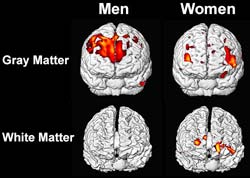
How Grey and White Matter Shape Intelligence in Men and Women

Men and women use different brain areas to achieve similar IQ results, UCI study finds
While there are essentially no disparities in general intelligence between the sexes, a UC Irvine study has found significant differences in brain areas where males and females manifest their intelligence.
The study shows women having more white matter and men more gray matter related to intellectual skill, revealing that no single neuroanatomical structure determines general intelligence and that different types of brain designs are capable of producing equivalent intellectual performance. “These findings suggest that human evolution has created two different types of brains designed for equally intelligent behavior,” said Richard Haier, professor of psychology in the Department of Pediatrics and longtime human intelligence researcher, who led the study with colleagues at UCI and the University of New Mexico. “In addition, by pinpointing these gender-based intelligence areas, the study has the potential to aid research on dementia and other cognitive-impairment diseases in the brain.”
Study results appear on the online version of NeuroImage.
In general, men have approximately 6.5 times the amount of gray matter related to general intelligence than women, and women have nearly 10 times the amount of white matter related to intelligence than men. Gray matter represents information processing centers in the brain, and white matter represents the networking of – or connections between – these processing centers.
This, according to Rex Jung, a UNM neuropsychologist and co-author of the study, may help to explain why men tend to excel in tasks requiring more local processing (like mathematics), while women tend to excel at integrating and assimilating information from distributed gray-matter regions in the brain, such as required for language facility. These two very different neurological pathways and activity centers, however, result in equivalent overall performance on broad measures of cognitive ability, such as those found on intelligence tests.
The study also identified regional differences with intelligence. For example, 84 percent of gray-matter regions and 86 percent of white-matter regions involved with intellectual performance in women were found in the brain’s frontal lobes, compared to 45 percent and zero percent for males, respectively. The gray matter driving male intellectual performance is distributed throughout more of the brain.
According to the researchers, this more centralized intelligence processing in women is consistent with clinical findings that frontal brain injuries can be more detrimental to cognitive performance in women than men. Studies such as these, Haier and Jung add, someday may help lead to earlier diagnoses of brain disorders in males and females, as well as more effective and precise treatment protocols to address damage to particular regions in the brain.
For this study, UCI and UNM combined their respective neuroimaging technology and subject pools to study brain morphology with magnetic resonance imaging. MRI scanning and cognitive testing involved subjects at UCI and UNM. Using a technique called voxel-based morphometry, Haier and his UCI colleagues converted these MRI pictures into structural brain “maps” that correlated brain tissue volume with IQ.
Dr. Michael T. Alkire and Kevin Head of UCI and Ronald A. Yeo of UNM participated in the study, which was supported in part by the National Institute of Child Health and Human Development.
About the University of California, Irvine: The University of California, Irvine is a top-ranked public university dedicated to research, scholarship and community service. Founded in 1965, UCI is among the fastest-growing University of California campuses, with more than 24,000 undergraduate and graduate students and about 1,400 faculty members. The second-largest employer in dynamic Orange County, UCI contributes an annual economic impact of $3 billion.














